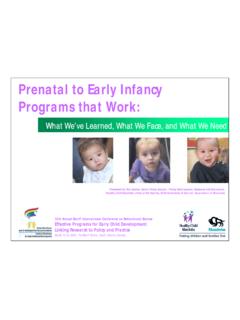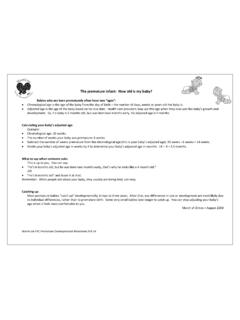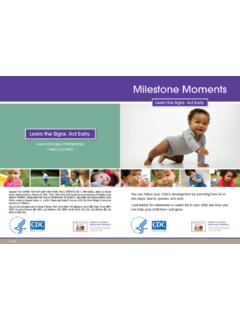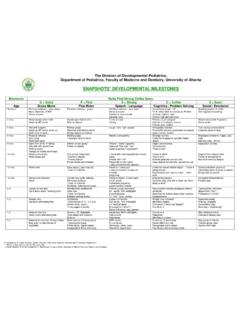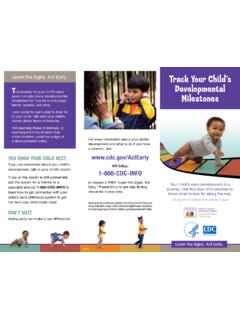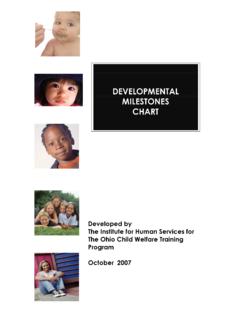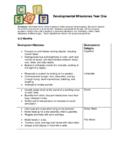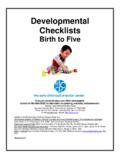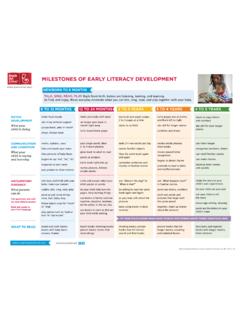Transcription of Responding to Children’s Needs - Excellence …
1 Important developmental Milestones in Young Childrenas when children learn to walk, but are lessfamiliar with important intellectual andsocial obtain these results, researcherswith the Alberta Centre for Child, Familyand Community Researchpolled 1,400parents and other adults who interact withchildren. They found that most peopleknew when and how children learned towalk, toss a ball or draw. When it came toquestions about attachment and develo -ping relationships, empathy, friendship,cooperation and commu nication, however,they weren t sure how to answer. So, to help parents, caregivers and thepeople who support them, the significantmilestones during a child s first five yearsof life are outlined Year of LifeAttachment, communication,personality and cooperation all begindeveloping as soon as a child is born andare well-established by a baby s shows that when mothersbreastfeed exclusively for at least sixmonths and continue for up to a year.
2 Theirchildren are more emotionally attachedResearch over the past few decadesclearly shows that the care childrenreceive as infants and toddlersinfluences the people they will indicate that when parents knowhow children develop, they are moreresponsive, sensitive, and skilful parents,and children are better off in both the shortand long to the Alberta BenchmarkSurvey: What Adults Know About ChildDevelopment*, parents have a goodunderstanding of physical milestones, suchNovember 2009 CEECD Parenting Series 1and also develop long term intellectualabilities. Some research shows thatbreastfed children cry less, are more alertand have better motor who breastfeed show improvedconfidence and nurturing also has importantnutritional and health benefits for children ,for example, protecting against somediseases and infections.
3 These advantagesmay be due to the milk itself, being held bymothers in a close and intimate way,frequent skin to skin contact, and verbaland visual communication between motherand child. Crying is the first stage in communi -cation for babies. Different cries indicateneeds and desires, but sometimes healthybabies cry for no apparent reason. Thelength of time babies cry varies babies cry between one and threehours per day for the first six weeks of length of time and the intensity of theircries increase until it peaks at about threemonths of age. Then, crying diminishes asbabies learn to communicate throughsmiling, touching or babbling.
4 Some babiescry excessively for no apparent reason andare difficult to soothe. These babies 2009 Responding to children s Needs CONTENTS Responding to children s Needs :Important developmental Milestonesin Young children .. 1 Building a Bond that Lasts a Lifetime .. 3 Learning is Child's Play .. 4 Sowing the Seeds of Friendship.. 5* For more information on this survey, 2009 CEECD Parenting Series often called colicky, but this usuallydecreases by about month begin to develop an emotionalattachment to their primary caregiver byabout six months of age. This process isknown as attachment.
5 Caregivers whoare warm, responsive and sensitive to theirchildren s Needs help them to build positiveattachments and relationships. Childrenwho trust at least one caregiver enjoy apersonal sense of worth and a belief inothers. They are self reliant, efficient,empathetic and competent from thetoddler years to adolescence. If theyremain attached to initial caregivers asthey grow up, they will continue to buildclose relationships with others throughoutlife. Attachment relationships also providechildren with an understanding andappreciation of their culture. children withinsecure attachments may suffer fromconduct disorder, aggression, depressionor anti-social behaviour later in life.
6 Recentresearch also suggests that children whoreceived mixed signals from caregivers(comforting and anger at the same time)face heightened risk for poor development.(For more about attachment, see thearticle on page 3.)Differences in a baby s temperament orways of Responding to the world and newpeople are evident from the early respond to new objects quickly;others respond more slowly or not at travel easily from one adult toanother; others insist on staying in theirmother s arms. Some are active; others arenot. Some are easily soothed and welcomenew experiences; others are hard to sootheand don t like new experiences.
7 Some laugha lot; others don t laugh very much. Parentsneed to learn how to respond sensitively totheir children s temperament and adjust tothe baby s their first birthday, babies beginsharing activities and objects with show an interest in other children andfamily members such as siblings andgrandparents. They also raise their arms tobe picked up by parents or caregivers andthey like to play games. One to Three YearsToddlers aged one to three yearsbecome more independent. They learnlanguage, become aware of themselvesand the Needs of others, and chooseactivities that interest them. By age two, children begin to develop patience, a senseof self control, and begin making , nurturing, curiosity, creativityand cleverness appear over the next about the age of three, all thesecharacter traits begin to define the child spersonality.
8 As parents impose rules and limits,often to protect the child s safety, conflictsoften occur. Toddlers who are upset andfrustrated may respond by screaming,biting, hitting or having temper difficult behaviours tend to decreaseas children s verbal and social skillsimprove. This time is important for youngchildren to learn to express emotionsverbally instead of having tantrums, tonegotiate instead of making demands, andreconcile with others after these skills at this age meansthey are likely to be maintained throughoutchildren s lives. The ability to speak languages developsprior to the age of three.
9 children firstexpress themselves using single words( juice for I want juice ), then progress totwo-word phrases ( want juice ) and thento three word ( I want juice. ) and morecomplex sentences ( I want juice in a redcup. ). Caregivers who repeat words,identify objects and ask frequent questionsduring this stage can improve languageability. Reading to children is alsoimportant for their early languagedevelopment and learning to to Five YearsAs toddlers become more verbal andtheir imagination and empathy grow, theychoose friends, form groups and cooperateto reach goals. (For more about peerrelations, see the article on page 5.)
10 Allthese skills are attained throughunstructured play and by interacting withfamily learn to play on their own firstor with adults. (For more about play, seethe article on page 4.) By age three, children spend much time playing next toother children and by age four, they aremore skilled at playing in small groups ofchildren. Some children prefer to playalone, while others are usually seenplaying with small groups of children prefer more cognitive toys( , puzzles, construction toys); otherslike to engage in pretend play ( , familyroles, storekeepers, firefighters); otherslike to construct things ( , in art or withblocks).
